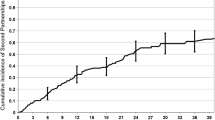Abstract
The goal of this study was to identify differences in the sexual health behaviors (condom use and number of sexual partners) between college students with same-sex sexual experiences and those with only opposite-sex partners. Data from a random sample of American university students were gathered as part of the 1997 College Alcohol Study. Odds ratios were estimated for consistent condom use and multiple sex partners for students with same-sex or both-sex sexual partners compared to those with exclusively heterosexual contacts. Five percent of respondents reported ever having a same-sex partner. Significant differences in safer-sex practices were found between groups. Females with both-sex experience and males with both-sex or only same-sex experiences were more likely to report multiple recent sexual partners than their peers with only opposite-sex partners. Odds ratios of consistent condom use were lower for men with only same-sex experience than among those with only opposite-sex partners. Findings have implications for sexual health education on the college campus. Consistent condom use remains low among college students. Education programs should emphasize the importance of limiting the number of lifetime sex partners, especially among students with same-sex experiences.
Similar content being viewed by others
REFERENCES
Aday, L. A. (1996). Designing and Conducting Health Surveys: A Comprehensive Guide, 2nd edn., Jossey-Bass, San Francisco, p. 110.
Alan Guttmacher Institute (1994). Sex and America's Teenagers, Alan Guttmacher Institute, New York and Washington.
Bishop, P., and Lipsitz, A. (1991). Sexual behavior among college students in the AIDS era: A comparative study. J. Psychol. Hum. Sex. 4: 135–148.
Bouldrey, B. (1999). Brave new world: We have money, we have Web. Do we have community? Do we need it? San Francisco Bay Guardian, June 23.
Centers for Disease Control and Prevention (1997). Youth risk behavior surveillance: National college health risk behavior survey-United States, 1995. MMWR CDC Surveill. Summ. 46(6): 1–57.
Centers for Disease Control and Prevention (1998a). Sexually Transmitted Disease Surveillance, 1997, United States Department of Health and Human Services, Public Health Service, Atlanta, GA.
Centers for Disease Control and Prevention (1998b). HIV/AIDS Surveill. Rep. 10(1): 14–15.
DeBuono, B. A., Zinner, S. H., Daamen, M., and McCormack, W. M. (1990). Sexual behavior of college women in 1975, 1986 and 1989. N. Engl. J. Med. 322(12): 821–825.
Diamond, M. (1993). Homosexuality and bisexuality in different populations. Arch. Sex. Behav. 22(4): 291–310.
DiClemente, R., Forrest, K., and Mickler, S. (1990). College students' knowledge and attitudes about AIDS and changes in HIV-preventive behaviors. AIDS Educ. Prev. 2: 201–212.
Douglas, K. A., Collins, J. L., Warren, C., Kann, L., Gold, R., Clayton, S., Ross, J. G., and Kolbe, L. J. (1997). Results from the 1995 National College Health Risk Behavior Survey. J. Am. Coll. Health 46: 55–66.
Garofalo, R., Wolf, R. C., Kessel, S., Palfrey, J., and DuRant, R. H. (1998). The association between health risk behaviors and sexual orientation among a school-based sample of adolescents. Pediatrics 101(5): 895–902.
Laumann, E. O., Gagnon, J. H., Michael, R. T., and Michaels, S. (1994). The Social Organization of Sexuality: Sexual Practices in the United States, University of Chicago Press, Chicago.
Leik, M., Malow, R. M., Ireland, S. J., Porter, L., and Lewis, J. E. (1995). HIV risk and drug use among college women. NIDA Res. Monogr. 151: 54.
Lewis, J. E. (1995). Psychosocial Correlates of HIV Risk Behavior Among College Students: A Test of the AIDS Risk Reduction Model, Dissertation, University of Miami.
Lewis, J. E., Malow, R. M., and Ireland, S. J. (1997). HIV/AIDS risk in heterosexual college students: A review of a decade of literature. J. Coll. Health 45: 147–158.
Liang, K. Y., and Zeger, S. L. (1992). Longitudinal data analysis using generalized linear models. Biometrica 73: 12–22.
MacDonald, N. E., Wells, G. A., Fisher, W. A., Warren, W. K., King, M. A., Doherty, J. A., and Bowie W. R. (1990). High-risk STD/HIV behavior among college students. JAMA 263: 3155–3191.
Mahoney, C. A., Thombs, D. L., and Ford, O. J. (1995). Health belief and self-efficacy models: Their utility in explaining college student condom use. AIDS Educ. Prev. 7: 32–49.
O'Leary, A., Goodhart, F., and Jemmott, L. S. (1992). Predictors of safer sex on the college campuses: A social cognitive theory analysis. J. Am. Coll. Health 40: 254–263.
Sanders, S. A., and Reinisch, J. M. (1999). Would you say you "Had Sex" if...? JAMA 281: 275–277.
SAS Institute. (1990). SAS/STAT User's Guide, Version 6, 4th edn. Vol. 1, SAS Institute, Cary, NC.
Wechsler, H., Dowdall, G. W., Davenport, A., and Castillo, S. (1995). Correlates of college student binge drinking. Am. J. Public Health 85(7): 921–926.
Wechsler, H., Dowdall, G. W., Meanner, G., Gledhill-Hoyt, J., and Lee, H. (1998a). Changes in binge drinking and related problems among American college students between 1993 and 1997: Results of the Harvard School of Public Health College alcohol study. J. Am. Coll. Health 47: 57–68.
Wechsler, H., Rigotti, N. A., Gledhill-Hoyt, J., and Lee, H. (1998b). Increased levels of cigarette use among college students: A cause for national concern. JAMA 280(19): 1673–1678.
Zeger, S. L., Liang, K. Y., and Albert, P. S. (1988). Models for longitudinal data: A generalized estimating equation approach. Biometrics 44(4): 1049–1060.
Author information
Authors and Affiliations
Rights and permissions
About this article
Cite this article
Eisenberg, M. Differences in Sexual Risk Behaviors Between College Students with Same-Sex and Opposite-Sex Experience: Results from a National Survey. Arch Sex Behav 30, 575–589 (2001). https://doi.org/10.1023/A:1011958816438
Issue Date:
DOI: https://doi.org/10.1023/A:1011958816438



